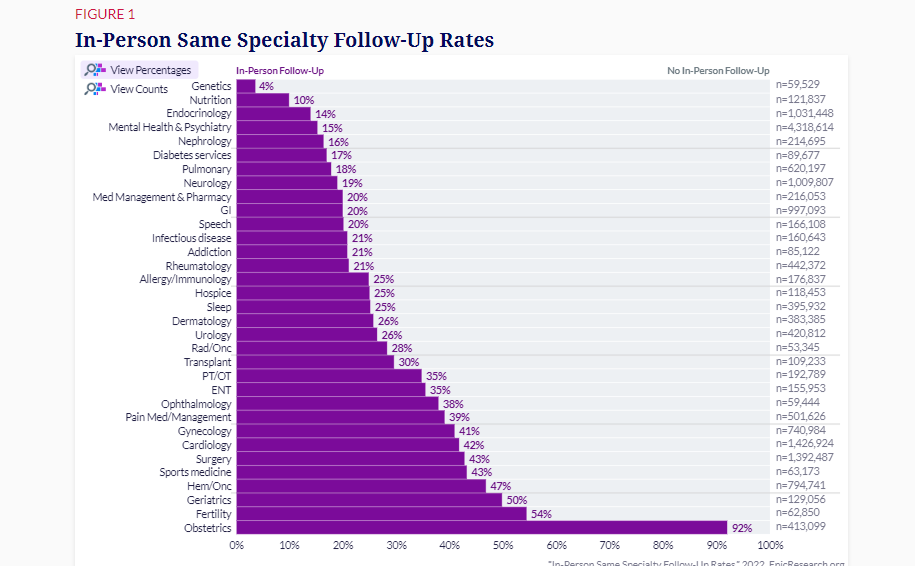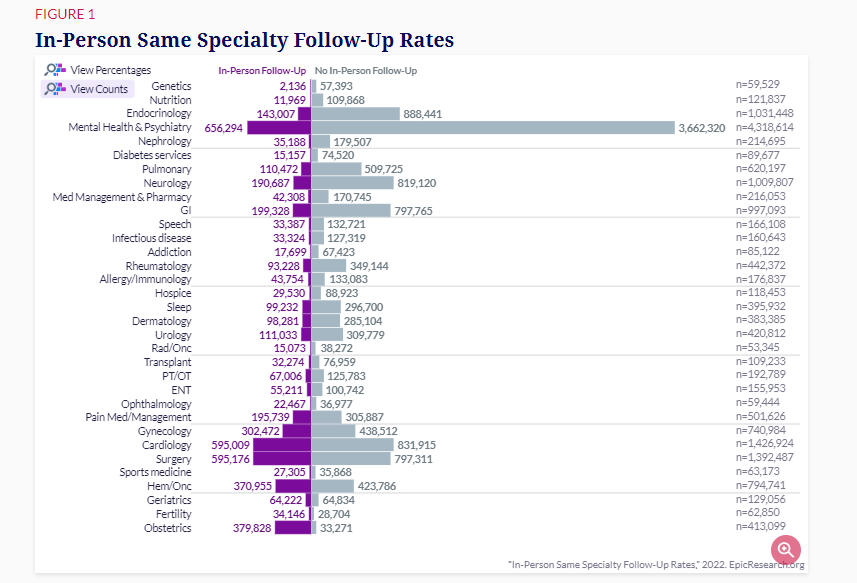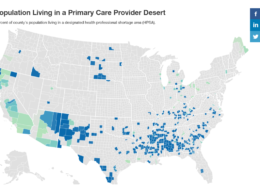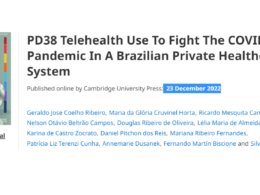the health institute – for continuous health transformation
Joaquim Cardoso MSc
Founder and Chief Researcher, Editor and Advisor
December 14, 2022
Key Findings
- In nearly every specialty studied, most patients who had a telehealth visit did not require an in-person follow-up appointment in that specialty in the next three months.
- For specialties that required follow-up, the additional visits were likely related to needing additional care, not duplicative care (for example, obstetrics, geriatrics).
- Mental health and psychiatry had the largest volumes of telehealth utilization and some of the lowest rates of needing in-person follow-up.
- Only 15% of the time did a patient who had a psychiatry or mental health telehealth visit need an in-person follow-up visit in the next three months.
- In specialties that could be consultations (for example, genetics, nutrition), telehealth visits might even replace the need for in-person visits.
- Genetics telehealth visits required in-person follow-up 4% of the time.
- Nutrition telehealth visits required in-person follow-up only 10% of the time.
Mental health and psychiatry had the largest volumes of telehealth utilization and some of the lowest rates of needing in-person follow-up.
In specialties that could be consultations (for example, genetics, nutrition), telehealth visits might even replace the need for in-person visits.
Recommended Actions
- Healthcare providers should continue to educate policymakers and administrators on the function telehealth plays as an alternative, rather than duplicative, encounter.
- Healthcare payers should extend telehealth visit coverage beyond the current waiver to support this method of care delivery and increased healthcare access.
Healthcare providers should continue to educate policymakers and administrators on the function telehealth plays as an alternative, rather than duplicative, encounter.
Healthcare payers should extend telehealth visit coverage beyond the current waiver to support this method of care delivery and increased healthcare access.
Infographic

ORIGINAL PUBLICATION

Telehealth Visits Unlikely to Require In-Person Follow-Up Within 90 Days
Epic Research
Dual Team Study
Team A: Jackie Gerhart, MD • Alex Piff
Team B: Kersten Bartelt, RN • Eric Barkley
December 13, 2022
Health care resources can be scarce, especially for rural communities, and information on the effectiveness of different methods for delivering care is important to guide decisions about how to allocate resources most effectively.
While telehealth use increased during the COVID-19 pandemic, some previous studies1 have suggested that telehealth might be a less efficient method of care than in-person visits for acute conditions.
We sought to determine which specialties were able to fulfill patient needs using telehealth and which required in-person follow-up visits more often.
We examined more than 35 million telehealth visits conducted between March 1, 2020, and May 31, 2022, to determine the overall rates of telehealth visits by specialty and to identify how often these visits require in-person follow-up within the same specialty.
We found that high follow-up rates were present only in specialties that unavoidably require regular visits with an in-person component for hands-on care, such as obstetrics and surgery.
We found that high follow-up rates were present only in specialties that unavoidably require regular visits with an in-person component for hands-on care, such as obstetrics and surgery.
Genetics and nutrition were the specialties that made the most efficient use of telehealth visits.
Their rates of needing in-person follow-up care in the three months after the telehealth visit were 4% and 10%, respectively.
Other specialties that made heavy use of telehealth had slightly higher rates of in-person follow-up, but many of these follow-ups may be additional appointments that are not duplicative but rather part of a regular cadence of care, such as monthly mental health visits.
FIGURE 1 — In-Person Same Specialty Follow-Up Rates

Figure 1: The dark bars show the percentage of telehealth visits for each specialty that had an in-person follow-up visit in that specialty in the next 90 days, and the lighter gray bars show the percentage of telehealth visits that did not have an in-person follow-up visit in that specialty in that timeframe.

These findings suggest that, for many specialties, telehealth visits are typically an efficient use of resources and are unlikely to require in-person follow-up care.
If telehealth is not duplicative of in-person visits for those specialties, it can be an effective tool to help expand access to care2.
If telehealth is not duplicative of in-person visits for those specialties, it can be an effective tool to help expand access to care2.
Notes about the research
These data come from Cosmos, a HIPAA-defined Limited Data Set of more than 170 million patients from 180 Epic organizations including 1,063 hospitals and more than 22,500 clinics, serving patients in all 50 states and Lebanon.
This study was completed by two teams that worked independently, each composed of a clinician and research scientists. The two teams came to similar conclusions.
- Hatef E, Lans D, Bandeian S, Lasser EC, Goldsack J, Weiner JP. Outcomes of In-Person and Telehealth Ambulatory Encounters During COVID-19 Within a Large Commercially Insured Cohort. JAMA Netw Open. 2022;5(4):e228954. doi:10.1001/jamanetworkopen.2022.8954
- Barbosa W, Zhou K, Waddell E, Myers, TE. Dorsey R. Improving Access to Care: Telemedicine Across Medical Domains. Annual Review of Public Health 2021 42:1, 463–481 doi:
References & additional information
See the original publication
Originally published at https://epicresearch.org












